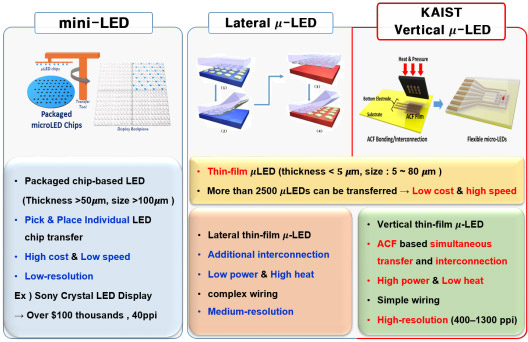- News
5 February 2018
KAIST develops flexible vertical micro-LEDs with three times optical power density of lateral micro-LEDs
© Semiconductor Today Magazine / Juno PublishiPicture: Disco’s DAL7440 KABRA laser saw.
A research team at the Korea Advanced Institute of Science and Technology. (KAIST) led by professor Keon Jae Lee of the Department of Materials Science and Engineering and professor Daesoo Kim of the Department of Biological Sciences has developed flexible vertical micro-LEDs (f-VLEDs) using anisotropic conductive film (ACF)-based transfer and interconnection technology (Lee et al, ‘Optogenetic Control of Body Movements via Flexible Vertical Light-Emitting Diodes on Brain Surface’, Nano Energy February 2018 issue). The team also succeeded in controlling animal behavior via optogenetic stimulation of the f-VLEDs.
Flexible micro-LEDs have become a strong candidate for next-generation displays due to their ultra-low power consumption, fast response speed, and excellent flexibility, says KAIST. However, previous micro-LED technology had critical issues such as poor device efficiency, low thermal reliability, and the lack of interconnection technology for high-resolution micro-LED displays.
The team has designed new transfer equipment and fabricated a f-VLED array (50x50) using simultaneous transfer and interconnection through the precise alignment of the ACF bonding process. These f-VLEDs achieved optical power density of 30mW/mm2 (three times higher than that of lateral micro-LEDs), improving thermal reliability and lifetime by reducing heat generation within the thin-film LEDs.

Figure. Comparison of μ-LED technologies.
These f-VLEDs (5 microns thick and less than 80 microns square) can be applied to optogenetics for controlling the behavior of neuron cells and brains. In contrast to the electrical stimulation that activates all of the neurons in the brain, optogenetics can stimulate specific excitatory or inhibitory neurons within the localized cortical areas of the brain, which facilitates precise analysis, high-resolution mapping, and neuron modulation of animal brains (ACS Nano, ‘Optogenetic Mapping of Functional Connectivity in Freely Moving Mice via Insertable Wrapping Electrode Array Beneath the Skull’).
In this work, they inserted the f-VLEDs into the narrow space between the skull and the brain surface and succeeded in controlling mouse behavior by illuminating motor neurons on two-dimensional cortical areas located deep below the brain surface.
“The flexible vertical micro-LED can be used in low-power smart watches, mobile displays, and wearable lighting,” says Lee. “In addition, these flexible optoelectronic devices are suitable for biomedical applications such as brain science, phototherapeutic treatment, and contact lens biosensors.”
Lee recently established a startup company (FRONICS Inc) based on micro-LED technology and is looking for global partnerships for commercialization.
www.sciencedirect.com/science/article/pii/S2211285517307784


